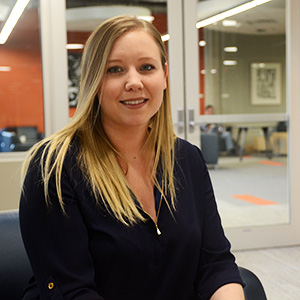As students enter their first year of university, they can find it overwhelming navigating the many academic opportunities and pathways available to them. They’re not only becoming familiar with the structure of university courses and timetables, they’re also trying to settle into a new social environment and meet new people. And given that first-year classes tend to be larger, some students may find it difficult to connect with classmates, instructors, and even the course material.
That‚Äôs why this fall, to assist in helping students transition to university, ĻŻĹī ”∆Ķ introduced First-Year Interest Groups (FIGs) for students in the Faculties of Science and Arts & Social Sciences.
Through weekly 50-minute sessions, held during the fall term, FIGs offered participants the opportunity to meet in small groups (15 participants maximum) with other first-year students who share similar academic interests.
‚ÄúMost science and arts students spend their first year as ‚Äėundeclared majors,‚Äô‚ÄĚ says Sandra Walde, associate dean, academic in the Faculty of Science. ‚ÄúThis is a good thing for most students, since it gives them the freedom to explore university offerings, and time to think about their interests and career goals before committing to a major. But it can also lead to them feeling a bit lost, as if they don‚Äôt belong anywhere yet.‚ÄĚ
Making connections
Led by senior undergraduate and/or graduate students, the FIGs allow Dal students to discuss some of the ideas coming out of their courses. Dr. Walde says the main goal was to help first-year students start connecting right away ‚ÄĒ to potential disciplines, opportunities in their fields of study, Dal faculty members, and to other students.
 Courtney Baumgartner (left), a first-year Marine Biology student from Toronto, registered for a  FIG to meet people who’ve been through her program.
Courtney Baumgartner (left), a first-year Marine Biology student from Toronto, registered for a  FIG to meet people who’ve been through her program.
‚ÄúI wanted to meet students in upper-year courses who could advise me in which direction I can take, which courses they would recommend, or other opportunities like the Seaside Program or co-ops,‚ÄĚ she says. ‚ÄúAnd then, of course, to meet other people in first year who are like-minded and also interested in protecting our oceans.‚ÄĚ
Learn more: Dal First-Year Interest Groups
Courtney participated in FIGS 0004: The Ocean, one of the  Science FIGs that were offered. The others ranged in topic from human health and the brain to systems, patterns and predictions. The seven Arts & Social Sciences FIGs covered such topics as literature and the performing arts, history and myth, and international politics and development.
‚ÄúI came here not really knowing what I wanted to do,‚ÄĚ says Riley Marchand, also a first-year Marine Biology student from Toronto who participated in the Ocean FIG. ‚ÄúI knew that I wanted to do Marine Biology, but I didn‚Äôt know anyone else in the program, so I wanted to meet other first-year students who are in the program and meet the TAs and get connected through them. I also wanted to start building a network and getting into areas of research.‚ÄĚ
Expanding horizons
FIGs not only allow for networking between fellow students, TAs and faculty members. They introduce students to research opportunities at the undergraduate level and, hopefully, open their eyes and minds to possible directions to take in their programs.
‚ÄúWe think we succeeded in these goals for many of the students,‚ÄĚ says Dr. Walde. ‚ÄúThey met experts in their areas of interest, upper-year and grad students in relevant programs, and they got to know students who are in their classes, and who will likely be in some of their classes in years to come. Some students joined departmental student societies, and a couple even began volunteering in research labs ‚ÄĒ not common for first-year students.‚ÄĚ
The FIGs also served to support students with skills that can benefit them both in and out of the classroom.
‚ÄúMy favourite session so far was probably learning how to study for success,‚ÄĚ says Courtney. ‚ÄúUpper-year students gave tips of ways to handle stress, handle the course load that‚Äôs coming, and sort of strategizing. I found that to be really helpful.‚ÄĚ
 One popular session was ‚Äúspeed dating‚ÄĚ in which various researchers, faculty members, and graduate students were invited to talk about their work, helping introduce students to future opportunities available in their field and the courses they‚Äôll need to take advantage of them.
One popular session was ‚Äúspeed dating‚ÄĚ in which various researchers, faculty members, and graduate students were invited to talk about their work, helping introduce students to future opportunities available in their field and the courses they‚Äôll need to take advantage of them.
‚ÄúI liked being able to talk with people who have already been through the program,‚ÄĚ says Riley (right). ‚ÄúPeople who were able to advise me and show me what worked well and what didn‚Äôt work well for them, so I could dip my toes into everything that‚Äôs interesting.‚ÄĚ
Moving forward
With the fall term now complete, Dr. Walde wants to build on what was accomplished during the first FIGs in order to expand their scope next year. That includes increasing the number of first-year students participating, and looking at new topic areas to cover.
‚ÄúNot all first-year students are looking for a FIG experience, of course, but we think there are many more who would both enjoy and benefit from them,‚ÄĚ she says. ‚ÄúSo we are offering a revised suite of FIG topics next year that we hope will appeal to a wider range of students."
Learn more: Dal First-Year Interest Groups

